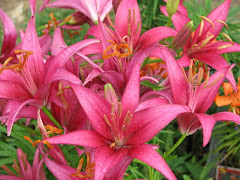
Today was a successful day because I learned something new. I didn't know a thing about cross pollination until late this afternoon when I picked a Black Beauty zucchini from a Golden Zucchini plant. I first noticed the bright yellow coloring on the green zucchini, then realized that I had plucked it from the golden and not the black plant. This has never happened in my garden before (that I know of)! After doing some research online, I now know why my purple jalapenos don't look like jalapeno peppers at all. I've grown plants from the same seed packet for about three years, but this year they have a different shape. I didn't have a clue before, but now I am blaming it on cross pollination. It's good to have answers.
I've also learned a thing or two about the dreaded squash vine borer. Aunt Susie has asked me several times if I have trouble with worms on my squash. I smugly assured her that I did not. I guess now I've gotten my comeuppance for being smug. When I told a co-worker about my dying zucchini plant, she told me the most disgusting tale about slicing open the root of her squash plant and removing a worm! I told her if that was the problem with my plant, the worm could have it. I think she was right, though. I removed some dead leaves from around the plant base and found that it was indeed mushy and oozing and totally repulsive. I found a link that show the worm inside a plant stem, as well as the adult moth.
I don't want the zucchini enough to dissect the plant and go looking for a worm. I'm a history major; I don't do dissections. The worm can have it.


















































